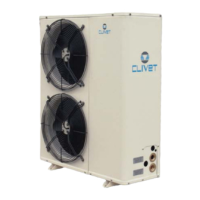Do you have a question about the CLIVET WSAN-EE 31 and is the answer not in the manual?
Explains the summer and winter cooling cycles, detailing refrigerant flow and heat transfer.
Describes the components and flow of the water circuit, including connections for heating and domestic hot water.
Provides important safety and operational precautions for unit installation, use, and maintenance.
Highlights areas requiring authorized personnel only, identifying internal and external danger zones.
Covers risks associated with moving, installing, and securing the unit to prevent toppling or falls.
Lists potential hazards like burning smells or contact with hot components and necessary precautions.
Details hazards related to the unit's electrical system, including power supply and earthing.
Warns about hazards from moving fan rotors and emphasizes disconnecting power before access.
Covers risks associated with refrigerant gas, including toxic effects, explosion, and fire hazards.
Addresses potential issues with the water system, such as leaks and short circuits.
Factors to consider for installing air-conditioning systems, including spaces and connections.
Specifies required space around the unit for operation, maintenance, and safety.
Details on outdoor installation, safety valves, anti-vibration devices, and avoiding specific environmental issues.
Covers piping design, intercepting valves, pressure indicators, tube insulation, and supports.
Details on preventing freezing with glycol, installation emptying, and expansion tanks.
Principles for electrical installation, safety, wiring, and system grounding.
Provides technical electrical specifications for different unit sizes, including current and power inputs.
Steps for connecting the unit to the power supply, ensuring safety and proper wiring.
Details on various remote ON/OFF, SUMMER/WINTER, and set point controls.
Manages domestic hot water production using a dedicated 3-way valve based on external requests.
Essential checks before initiating unit operation, including glycol percentage and fan clearance.
Verifies system integrity, pressure, and electrical connections before startup.
Specific procedure for units with crankcase resistances, requiring pre-heating.
Checks power supply voltage, phase balance, and unit current draw.
Monitors key parameters like pressure, temperature, and liquid line for circuit health.
Lists all alarm codes, their types (faulty, pre-alarm), and reset procedures.
Identifies causes for high/low pressure alarms in cooling mode and troubleshooting steps.
Troubleshooting steps for faulty probes and pressure transducers, including checks and replacements.
Explains the summer and winter cooling cycles, detailing refrigerant flow and heat transfer.
Describes the components and flow of the water circuit, including connections for heating and domestic hot water.
Provides important safety and operational precautions for unit installation, use, and maintenance.
Highlights areas requiring authorized personnel only, identifying internal and external danger zones.
Covers risks associated with moving, installing, and securing the unit to prevent toppling or falls.
Lists potential hazards like burning smells or contact with hot components and necessary precautions.
Details hazards related to the unit's electrical system, including power supply and earthing.
Warns about hazards from moving fan rotors and emphasizes disconnecting power before access.
Covers risks associated with refrigerant gas, including toxic effects, explosion, and fire hazards.
Addresses potential issues with the water system, such as leaks and short circuits.
Factors to consider for installing air-conditioning systems, including spaces and connections.
Specifies required space around the unit for operation, maintenance, and safety.
Details on outdoor installation, safety valves, anti-vibration devices, and avoiding specific environmental issues.
Covers piping design, intercepting valves, pressure indicators, tube insulation, and supports.
Details on preventing freezing with glycol, installation emptying, and expansion tanks.
Principles for electrical installation, safety, wiring, and system grounding.
Provides technical electrical specifications for different unit sizes, including current and power inputs.
Steps for connecting the unit to the power supply, ensuring safety and proper wiring.
Details on various remote ON/OFF, SUMMER/WINTER, and set point controls.
Manages domestic hot water production using a dedicated 3-way valve based on external requests.
Essential checks before initiating unit operation, including glycol percentage and fan clearance.
Verifies system integrity, pressure, and electrical connections before startup.
Specific procedure for units with crankcase resistances, requiring pre-heating.
Checks power supply voltage, phase balance, and unit current draw.
Monitors key parameters like pressure, temperature, and liquid line for circuit health.
Lists all alarm codes, their types (faulty, pre-alarm), and reset procedures.
Identifies causes for high/low pressure alarms in cooling mode and troubleshooting steps.
Troubleshooting steps for faulty probes and pressure transducers, including checks and replacements.











